With my first baby, I was anxious to have a back-up formula in case my breastfeeding plan went awry. I knew that the chances of finding a good, or indeed any, plant-based formula in a pinch were pretty slim. Just knowing the can was there offered great peace of mind!
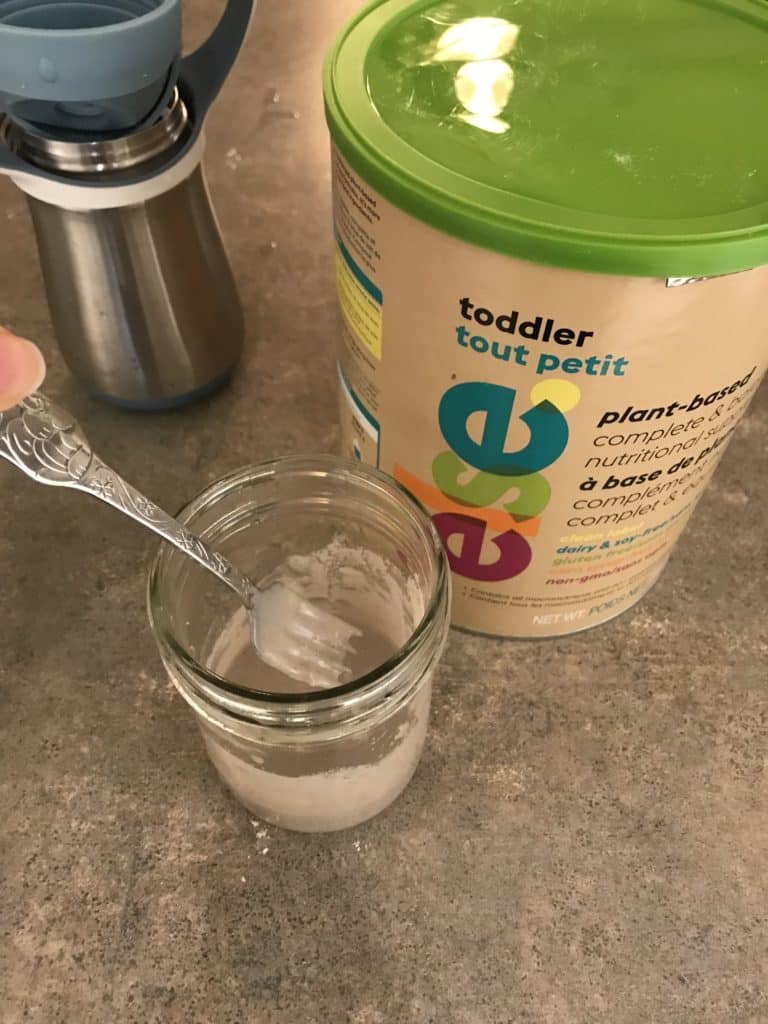
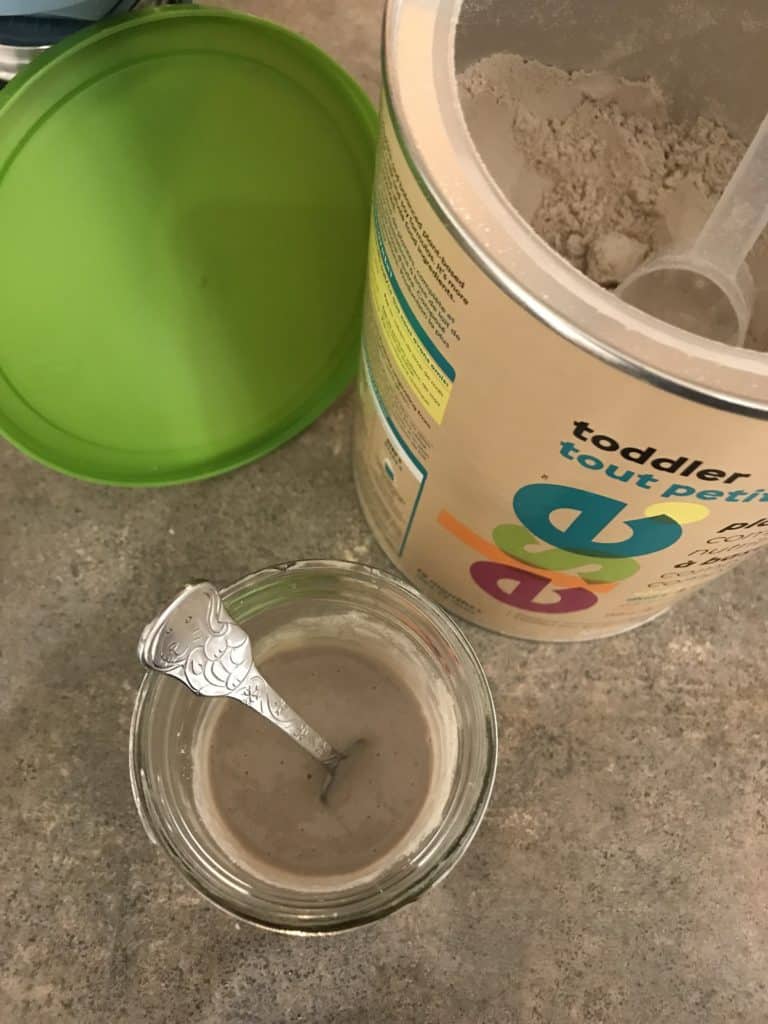
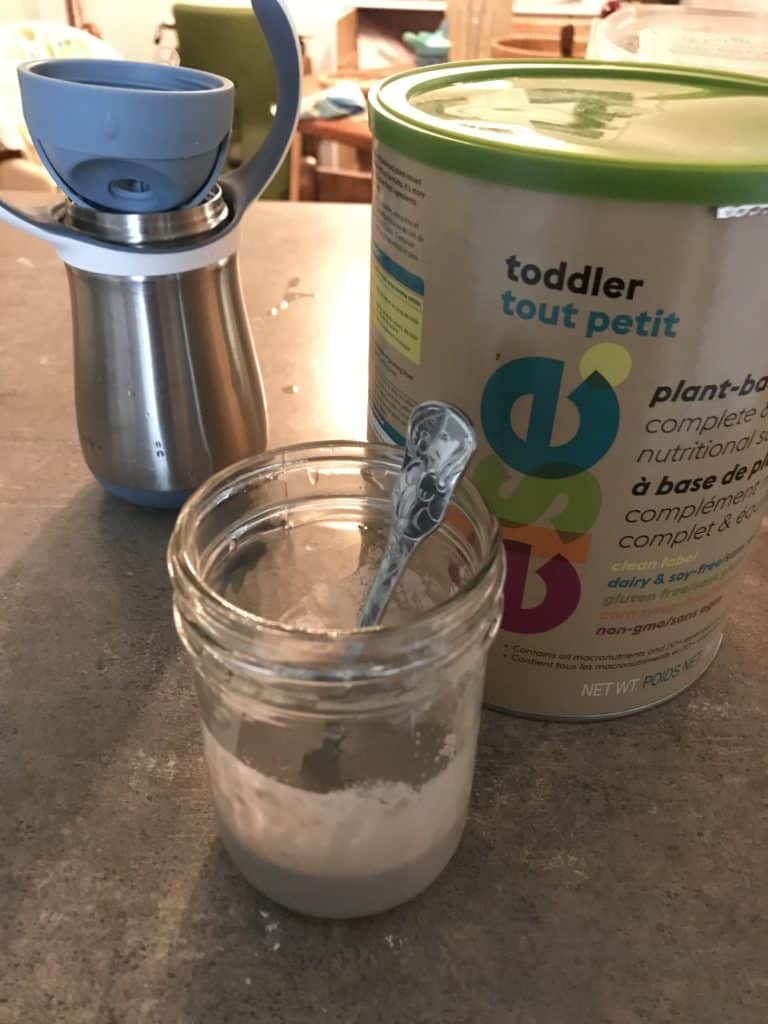
If you’re raising a vegan baby, like I am, check out my recommendations for the best organic plant-based baby formula below. These formulas are also great for anyone who wants a more eco-friendly formula option, and for infants with a cow’s milk allergy.
Before my top picks, I get back to my nerdy nutritionist roots with a discussion of:
- Infant nutrition needs
- What to avoid in baby formula
- How to choose a good infant formula.
The long and short of it is that compared to cow’s milk formula, plant-based formula has a significantly lower carbon footprint and requires far less water to produce. It can also be a safe, healthy, and sustainable choice for infants, whether they’re vegan, vegetarian, or omnivorous.
Baby formula – 101
Baby formula as we know it was invented in 1865 by chemist Justus von Liebig. The first commercial formula was liquid, but Liebig soon created a powder form with a longer shelf life. The ingredients? Cow’s milk, wheat and malt flour, and potassium bicarbonate – then considered ideal infant food.
In the years that followed, manufacturers added in all kinds of things, including corn syrup, dubious vegetable oils, and GMO soy. And, frankly, not much innovation happened in the world of baby formula up until a few years ago.
See also: Glyphosate in Oats: Everything You Need to Know
Thankfully, there are now several formulas available with far healthier and more sustainable ingredients. Some of these are plant-based, but most aren’t entirely vegan. It’s also very hard, but not impossible, to track down vegan baby formula in North America.
Buying formula is also immensely confusing. This is partly caused by differing regulations governing formula composition and advertising in the US and Europe. Whether you’re planning to import formula or buy U.S.-made, here’s the lowdown on what to look for and what to avoid.
Free eBook: Simple Steps to a Greener Home
Concerned about climate change? Learn actionable tips for making each room in your home greener.
"*" indicates required fields

PRE, Stage 1, 2, 3, and 4 baby formula – um… what?
If you’ve never had cause to buy formula in the U.S. before, you’d be forgiven for assuming that the big ‘PRE’ label on the front of some products means the formula is for premature babies (AKA premies). Nope. In the US, PRE formula is just meant for very hungry young infants who eat frequently and thus need a starch-free formula that is quickly digested, rather than for premies.
Annoyingly, most formula in the US is marketed as one-size-fits-all, at least up until 12 months (with some exceptions). Meanwhile, in Europe, pre-stage formula is for premature babies. After that, there’s Stage 1 formula which is for babies 0-6 months, and Stages 2 and 3 for babies 6-12 months. Stage 4 formula is intended for toddlers over a year old.
This stratification makes sense because very young infants, older infants, and toddlers have vastly different nutrient needs. Sure, all baby formula needs to include all essential vitamins and minerals, omega-3 fatty acids, a good amount of carbohydrate, fat, and protein, but the amounts and ratios of these vary a lot throughout the first year of life and beyond.
This variation is reflected in the significant changes in breastmilk composition from month to month and even from minute to minute.
Matching formula to breastmilk – an impossible task?
In general, breastmilk comprises “87% water, 3.8% fat, 1.0% protein, and 7% lactose,” with the fat and lactose, respectively, providing 50% and 40% of the total energy of the milk. However, the foremilk (milk expressed first) is thinner and has a higher lactose content to satisfy a baby’s hunger quickly, while the hindmilk is much fattier.
Lactose gets a bad rap in some quarters but is rarely a problem for babies. Lactose intolerance is quite common in older children, however, because of decreased production of the lactase enzyme needed to digest breastmilk. This makes sense, given that adults no longer need to drink milk to survive and thrive. That we continue drinking other species’ milk and can’t digest it seems less a problem to be solved with enzyme pills and more a problem to be solved with dietary choices.
For infants, lactose is a great source of calories and is usually very easily digested. It is a disaccharide composed of glucose and galactose, and after digestion in the small intestine, almost all the absorbed galactose is converted to glucose 1-phosphate by the liver and can be used for glycogenesis, i.e., as an energy store in the muscles and liver. Lactose also helps the body absorb calcium and other minerals. Overall, lactose levels in breastmilk are fairly constant. This isn’t the case with fat and protein, the content of which changes as babies mature.
As lactose is a sugar, you’ll notice that the breakdown above leaves just 10% or so of energy coming from protein. This also changes, with protein content decreasing from 1.4-1.6 grams per 100 mL in the first few weeks to 0.8-1.0 g/100 mL at 3-4 months, and then to even less, at 0.7-0.8 g/100 mL after 6 months.
No wonder manufacturers have a hard time creating anything like a biosimilar baby formula!
What to do about formula, then?
Many formulas are advertised as intended for toddlers, rather than infants. This is partly because health authorities want to prevent companies (ahem, Nestle) from actively promoting formula as preferable to breastmilk. It’s also partly the result of a need for significant (and expensive) testing required before a company can market formula for infants.
Some readers may also want to check out the CDC’s page on choosing an infant formula.
This degree of regulation makes a certain amount of sense, given that infants before six months typically rely solely on formula or breast milk for nutrition. However, it also makes things quite confusing when trying to choose a formula for, say, a seven-month-old who is also eating solids.
The solution is to only use a formula that has been approved by regulatory authorities as suitable for the age of your baby. Using a formula designed for older infants or much younger infants could run a risk of creating nutrient deficiencies, digestive troubles, or overfeeding issues. For folks in the U.S., this might mean importing a plant-based baby formula approved in another country instead of relying on generic formula available stateside.
Importing baby formula
Importing baby formula poses its own concerns though. For instance, it’s harder to find out if an imported product is subject to a recall notice, and imported products may have been irradiated. Transit and warehousing can also make for shorter expiry dates once your formula arrives, making it hard to buy in bulk and save costs (form a buyer’s club with other parents instead!). Fake products are also a concern, meaning it’s key to find a reputable seller.
Furthermore, manufacturers in Europe are not legally allowed to market formulas as organic if they contain any synthetic nutrients. This sounds like a good thing but can actually mean that formulas aren’t as complete as you’d expect, with some lacking key vitamins and minerals, for example. There are ways around this, such as choosing an organic European formula and then adding in (with a nutritionist’s help) any missing nutrients (such as the fatty acid DHA) from reliable, infant-safe sources.
Heavy metals and other toxins in infant formula
Heavy metals are a big concern in infant formula, given the outsized adverse effects these can have on a tiny baby body. The big three are arsenic, lead, and mercury, but while the FDA does set limits on allowable levels in other foods and in bottled water, it doesn’t set limits for heavy metals in baby food. The one exception is for arsenic levels allowed in rice cereal (currently 100 parts per billion).
Free eBook: Simple Steps to a Greener Home
Concerned about climate change? Learn actionable tips for making each room in your home greener.
"*" indicates required fields

Arsenic in rice
Rice is a key potential source of arsenic exposure. Horrifyingly, a 2012 study found that one organic infant formula containing brown rice syrup had a staggering six times the Environmental Protection Agency’s safe limit for arsenic.
In the European Union, the limit for lead is 20 ppb and the limit for cadmium is 10-15 ppb. The American Academy for Pediatrics recommends levels of lead no higher than 1 ppb in food and drink intended for babies.
Given that there’s no government oversight helping you out here, you’ll want to see third-party testing for heavy metals in any baby food you buy. You can also take steps to minimize the risk of exposure by using filtered water to mix formula, as long as the filtering captures heavy metals.
If you’re really stuck for a properly tested formula, the next best approach is to avoid any formula that contains rice-based ingredients such as brown rice syrup.
Aluminum
Despite health concerns, and there being limits on aluminum levels in ingredients, there’s no specific testing required for overall aluminum in formula.
Soy formula poses a particular risk of high levels of aluminum because of how the plant sucks up aluminum in soils. Soy isn’t the only type of formula posing a risk of aluminum exposure, however. Even cow’s milk formula can contain high levels of aluminum, in part because manufacturers sometimes use additives and processes that increase aluminum levels. For instance, some formulas include powdered milk treated with aluminum to prevent clumping.
Two of the simplest ways to minimize your baby’s exposure to aluminum are to avoid soy-based formulas and check that any cow’s milk formula isn’t made with powdered milk. You can also look for independent, third-party testing of every batch.
BPA
In the U.S., the FDA has banned the use of Bisphenol-A in formula can linings. This is great, but it doesn’t prevent manufacturers from using similar compounds such as BPS or BPF. BPA is a known endocrine disruptor, making it especially troublesome for babies just developing their hormonal systems.
If you’re importing formula from outside the U.S., check that the cans are BPA-free at least. If you can, check formula containers are free of all bisphenols.
Sugars in infant formula
If you’ve ever tasted formula, you’ll know it’s quite sweet. This isn’t because formula makers are trying to get our babies hooked on sugar, it’s because breastmilk itself is quite sweet due to the high lactose content. In fact, human milk has a much higher lactose content than cow’s milk (about 50% higher) and is joined by fellow carbohydrates oligosaccharides and glucose.
Manufacturers use various sweeteners to mimic both the caloric content and natural sweetness of milk. These sweeteners include corn syrup, sucrose, brown rice syrup, and maltodextrin. Babies don’t need these sweeteners, of course, and they can pose a bevy of health concerns. Potential issues include heavy metal contamination and a higher risk of overfeeding, problematic appetite development, dental issues, and obesity. Recognizing these issues, sucrose and some other sugars are banned in infant formula in the EU.
Lactose is the most obvious choice for a sweetener in formula but isn’t an option for plant-based babies as lactose only (currently) comes from other animals’ milk. Instead, the better lactose-free formulas tend to provide sweetness and calories from pre-cooked starch, gelatinized starch, and maltodextrin.
Free eBook: Simple Steps to a Greener Home
Concerned about climate change? Learn actionable tips for making each room in your home greener.
"*" indicates required fields

Maltodextrin in infant formula
Maltodextrin is similar to lactose in energy value, is highly digestible, and helps reduce the osmotic load and related gastrointestinal distress (basically, diarrhea) in infants who have trouble tolerating lactose. There are no known adverse effects of maltodextrin on growth and development and, interestingly, research in piglets suggests better cognitive performance with maltodextrin-based formula. However, because the use of maltodextrin in formula is relatively recent, we have no data on its long-term health effects.
In contrast, there is data on infants fed formula containing glucose (corn) syrup. Specifically, researchers have found that breastfed babies fed lactose-free formulas sweetened with corn syrup solids had much lower levels of blood glucose and non-esterified fatty acids 120 minutes after feeding compared to similar infants fed a lactose-based formula. However, both the lactose and non-lactose formulas led to significantly elevated insulin levels compared to breast-fed infants.
Maltodextrin is a complex carbohydrate, is easily digested, and provides energy for growing infants. It is also much less likely to cause tooth decay compared to corn syrup solids or other glucose syrups.
Sustainable ingredients in infant formula
Babies get through a lot of formula in those first six months alone, so if you care about the environment, you’ll want to make sure your plant-based formula is sustainable. This means checking the ingredients list for genetically modified organisms, including GMO soy or corn, and choosing formulas made with mostly organic ingredients. This helps support a more sustainable approach to farming, with fewer pesticides, herbicides, and chemical fertilizers.
You’ll also want to ensure your chosen formula doesn’t contribute to deforestation and habitat loss. Huh? Yup, lots of formula includes palm oil, which is not only terrible for orangutans and other at-risk species, but it’s also problematic for babies.
Despite the name, palm oil isn’t identical to the palmitic acid (a fat) found in breastmilk. The body has a harder time digesting palm oil and it can reduce calcium absorption, which obviously isn’t good for growing babies.
For the sake of your baby and baby orangutans, avoid palm oil in formula. Coconut oil is a good alternative. At a push, choose a formula where sustainably sourced palm oil and vegetable oils are mixed with enzymes that make the blend more like palmitic acid in breastmilk.
GMOs in infant formula
If a product doesn’t specify that any soy or corn is non-GMO, chances are that it is genetically modified. While I’m not anti-GMO per se, I am concerned that genetically modified soy and corn are so widespread in the U.S. and worldwide. This is because it increases the use of dangerous chemicals such as glyphosate and destroys biodiverse ecosystems. The sale of GMO crops and seeds also puts too much power in the hands of big agricultural companies, destroying the ability of smallholder farmers to earn a living in a sustainable, healthy way.
Soy in infant formula
Soy formula is the most commonly available choice for vegan families. That said, most soy formula contains vitamin D3 sourced from sheep lanolin. This is where things get tricky if you’re definitely looking for a vegan formula. Watch for labeling such as ‘plant-based’ or ‘dairy-free’, rather than vegan. Some of these formulas contain vitamin D3 from lichen or mushrooms, but most will still use D3 from sheep or fish.
By law in the US, soy-based infant formulas must contain the same amount of calories and the same essential nutrients as any other approved baby formula, including cow’s milk formulas. This means soy formula can meet a baby’s growth and developmental needs just as well.
Soy-based formulas are good options for babies with galactosemia or congenital lactase deficiency, as well as for vegan babies. Despite claims that soy formula may help with colic, the evidence is inconclusive. Soy formula is also sometimes marketed as an option for babies with known cow’s milk allergies. However, some infants who are allergic to cow’s milk may also be allergic to soymilk. And, if your baby has any diagnosed food allergies, it’s best to avoid soy products in the first six months and consult your pediatrician before introducing soy and other common allergens (such as egg, peanuts, tree nuts, etc.).
Soy formula does tend to have higher levels of aluminum and phytates compared to other types of infant formula. For most babies, these won’t present an issue, but for babies with impaired kidney function, specific nutrient deficiencies, or malabsorption issues, it’s best to talk to your pediatrician before using a soy formula.
Millions of infants have grown and thrived on soy-based infant formula in the last half-century. Despite this, some folks have raised concerns about the safety of soy for infants.
Soy isoflavones and infant formula safety
Concerns about soy safety usually arise as a worry over the ‘feminization’ of boys. This is because soy is a source of phytoestrogens called isoflavones. These plant compounds have a similar structure to the hormone estrogen which is responsible for much of female sexual development. Isoflavones are also found in other plant foods, such as chickpeas.
Babies on soy-based formula typically consume more isoflavones than breastfed babies or those on cow’s milk or other plant-based formula. And because formula is the exclusive source of nutrition for the first six months of life, these babies also typically consume more soy isoflavones than most adults eating soy foods on occasion.
The worry, then, is that soy-fed infants may be filling up on estrogen during a period of development when estrogen levels are usually low. Soy isoflavones are not exact replacements for estrogen though. In fact, they’re quite distinct and much less potent than estrogen. The human body also metabolizes soy isoflavones differently than non-human animals used in some of the studies that have sparked fear over soy’s potential estrogenic effects.
Does soy have a ‘feminizing’ effect?
I have many thoughts about the scaremongering over soy. All I’ll say here, though, is that if your main concern with soy is the idea that it will make a boy baby more feminine or affect his sexual development, researchers have looked into that. Specifically, there is no evidence that babies assigned a male gender at birth who are fed soy formula have any differences in gender-role play behavior compared to other male infants who are breastfed or consume non-soy-based formula.
Other studies have found that boys who were fed soy formula had no negative effects on hormone levels and development of reproductive organs. Researchers have also concluded that there is no evidence to support the idea that male or female infants fed soy have earlier onset puberty. Unless your baby has congenital hypothyroidism (where you’d be working with a pediatrician anyway), there’s little reason to avoid (or, indeed, favor) soy-based infant formulas.
Sure, soy isn’t a natural food for a human infant, but neither is cow’s milk, which is a source of estrogens and is meant for fast-growing calves.
The bigger concern with soy is genetic modification. So, if you’re satisfied that soy doesn’t pose a health risk to your baby but want to avoid GMOs, choose a GMO-free, organic soy-based formula.
Preparing formula safely
There are plenty of things to consider when buying formula. Once you’ve made your choice, don’t undo your good work by using any old water, bottle, and nipples to feed your baby. It’s always best to use filtered, boiled and slightly cooled water to prepare formula. This can help minimize exposure to chlorine, fluoride and other chemicals that may pose a safety risk for infants. Choose BPA-free silicone nipples and glass bottles to minimize your baby’s exposure to plastic and plasticizers.
Free eBook: Simple Steps to a Greener Home
Concerned about climate change? Learn actionable tips for making each room in your home greener.
"*" indicates required fields

Dairy-free, plant-based, or vegan?
If you’ve been vegan a while you’re probably already contending with the growing confusion over the term ‘plant-based.’ Plant-based formulas are no different, in that they typically contain mostly plant-derived ingredients but aren’t necessarily entirely free of animal-derived ingredients, meaning they’re not strictly vegan.
The main issue with formula is that, at least in the U.S., manufacturers have to include vitamin D3.
Vitamin D in formula
Vitamin D is essential for the development of healthy bones and teeth, as well as for immune function and hormonal health. Supplements are widely available in the form of D3 from lanolin, a waxy substance found in sheep’s wool.
Vitamin D2 is the vegan version of the nutrient but is less effective at raising blood levels of active vitamin D. There are some vegan versions of vitamin D3 available, such as from lichen or mushrooms, but these tend to be much more expensive and harder to track down. Unsurprisingly, formula companies tend to go for the cheaper, easier option, which means most formula isn’t vegan even if everything other than the vitamin D3 is plant-based.
Your choices, then, are to:
- Find a vegan formula from overseas (namely Sprout Organics)
- Track down the one approved vegan infant formula in the U.S. (Else Nutrition)
- Choose a non-vegan formula that is as close as possible to 100% plant-based.
Alternative options to vegan baby formula
If you’re really struggling to find a vegan baby formula you feel comfortable with, and you can’t or don’t want to nurse your baby, consider asking your friends with young infants to see if anyone has an oversupply issue or a stash of breastmilk they could give you. You may even have access to a nearby milk bank.
If you are giving your baby some human milk as well as formula, a vitamin D supplement is also recommended as breast milk does not provide adequate amounts for infant health. I use vegan vitamin D3 drops (view here) derived from lichen for my baby. Having used a few different options, I would recommend drops diluted in olive oil; it’s a lot easier than using more concentrated drops once your baby is old enough to grab a pipette!
And if you’re looking for a plant-based formula because you’re vegan, remember that veganism seeks to exclude all forms of exploitation of and cruelty to animals as far as is possible and practicable. You and your baby won’t lose your vegan cards if you choose to use a formula with some animal-derived ingredients for those first six months. After all, fed is best, be that human milk, formula, or a combination thereof.
Can’t babies just drink plant-based milk instead of formula?
Nope! Babies need human breast milk or properly designed formula in order to thrive and grow. Milk, whether plant-based or from another species, does not provide the right nutrients or energy profile to properly nourish a human infant.
Remember, cow’s milk formula isn’t just cow’s milk in powder form. Instead, this is processed cow’s milk, where manufacturers have tinkered with proteins, sugars, and fats, and then fortified the product with vitamins, minerals, fatty acids, and other essential nutrients. Indeed, pediatric nutritionists don’t recommend feeding babies any cow’s milk until 12 months.
Plant-based milks should also be limited before 12 months, in part because any milk can make a baby feel full, thus limiting their intake of breastmilk or formula that provides greater all-round nourishment.
After a baby is a year old, or thereabouts, it’s fine to introduce a little bit of soy, almond, cashew, rice, hemp, pea, or other plant-based milk as long as it’s unsweetened. These should be part of a balanced diet, however, and not a substitute for solid foods.
Finally, while it may seem tempting to go the DIY route and just make a vegan baby formula at home, this is a definite no-no. It is highly unsafe. There’s a risk of potential bacterial contamination, imprecise measurements, and unsafe ingredients, in addition to being nutritionally inadequate and inappropriate.
For all their faults, manufacturers of infant formula at least have research and development going for them. Not to mention rigorous regulation and testing and accountability if a formula doesn’t meet basic standards.
How to choose a better baby formula
I just threw a lot of information at you, which is exactly what every new parent doesn’t need. If you’re still blissfully pregnant and considering formula options, take your time to digest the info above. If you’ve got a hungry baby right now, however, here’s the condensed version.
- Because of strict FDA regulations over formula for infants 0-12 months, there’s just one approved vegan infant formula available in the U.S. (Else Nutrition) – all other formulas contain non-vegan vitamin D3 from lanolin.
- Regulations aren’t as strict for formula for toddlers, so things get easier after your baby reaches 12 months.
- You can usually avoid GMOs, many pesticides, and antibiotic and hormone residues by choosing a plant-based, organic infant formula.
- In the EU, organic formulas aren’t allowed to contain synthetic ingredients, which can mean they’re not nutritionally complete. In the U.S., organic formulas get a pass for synthetic nutrients such as folic acid.
- If a formula contains ingredients such as canola oil, DHA, AA, lutein, etc., look for information on how these were extracted, and choose those free from hexane or toluene.
- Lactose is a sugar, so expect to see a similar sugar in any baby formula, be it lactose from cow’s milk or a plant-derived sugar. Avoid fructose and corn syrup, and brown rice syrup unless it’s third-party tested for heavy metals. Ideally, choose a formula with maltodextrin, which is more easily digested and used by infants to support healthy growth and development.
- Soy is not feminizing and is generally a safe option for infant formula, unless a baby has allergies, or thyroid or kidney issues.
- Cow’s milk and plant milks are not safe substitutions for human milk or properly designed formula and can cause serious malnutrition and death in infants.
- Do not try to DIY a formula, vegan or otherwise. This is extremely dangerous.
- Baby has to eat, so learn an important parenting lesson now and throw out any ideas of perfection.
On that last point, I’m serious. If you can’t find the perfect formula or are having trouble importing the one you want, feed your baby a good enough formula and focus your energy on other things. You can always check in from time to time to see if new formula options are available.
Free eBook: Simple Steps to a Greener Home
Concerned about climate change? Learn actionable tips for making each room in your home greener.
"*" indicates required fields

Our top picks
My top recommendations for organic plant-based baby formula include U.S., Australian, and European formulas.

Sprout Organic Plant-Based Infant Formula
Highlights: My top choice for a totally vegan infant formula. Organic, non-GMO, and Kosher, with no added sugar. Available in fully recyclable, BPA-free tins. Use code LEAFSCORE15 for 15% off.
Editorial note for US-based readers: This product, while our top pick, ships from Australia; if you’re more pinched for time, or if your bank tends to struggle with exchange rates, give our runner up a look for an option closer to home.
Sprout Organic Plant-Based Infant Formula is a world-first vegan formula designed and approved for babies 0-12 months. If I could have gotten my hands on Sprout Organic’s Infant Formula prior to having my baby, I would have. Alas, the Australian company only launched in June, 2021 and didn’t immediately ship to North America. Happily, Sprout Organic now offers worldwide shipping and plans to expand internationally.
This formula is based on rice starch rather than soy. While this raises concerns about heavy metal contamination, Sprout Organic formulas comply with Australian regulations on heavy metals, including arsenic.
Australia and New Zealand have robust standards for infant formula. This includes regulations governing levels of micro and macro nutrients needed for healthy growth and development. Rigorous tests and safety checks are required for approval for sale, including serious pharmaceutical grade Good Manufacturing Practices (GMP) standards.
Before bringing this formula to market, Sprout Organic conducted its own review process through pediatricians, nutritionists, midwives, and parents. Though I haven’t tried this formula myself, it’s a huge hit with parents of plant-based babies worldwide. It’s also gaining favor with parents of babies with allergies.
The formula includes DHA and AA, as well as vegan vitamin D2. The main carbohydrate source is organic rice starch, with organic coconut and canola oil, and organic rice and pea protein. It has no added sugar, not even maltodextrin.
Sprout Organic makes its products in Melbourne and on the Gold Coast of Australia. The company sources ingredients as locally as possible, with the exception of organic rice (which isn’t grown organically in Australia). Sprout Organic adheres to the HACCP protocol. This means it knows the cooperative regions and growers directly supplying raw ingredients for its products.
All products are certified by Vegan Australia. The formula and Junior Protein tins are fully recyclable and BPA-free, including lids and scoops.
You can store this formula unopened for 18 months. Once opened, Sprout Organic recommends using the formula within four weeks. Sprout Organic doesn’t offer formula samples but is working to launch a 5-sachet travel pack. This would make a good sample pack if you’re curious about the product. The company also offers a generous refund policy in case the formula really doesn’t work out for your baby.
The company is also a member of the Australian Infant Nutrition Council. Sprout Organic is family owned and clearly committed to bringing safe, plant-based choices to market to support more families. It is also committed to providing Kosher, hypoallergenic products free of eggs, fish, milk, peanuts, shellfish, soy, and wheat.
The company also makes plant-based snacks for older babies and children, as well as nutrition drinks for older children. A neutral flavor toddler formula is set to launch in September or October, 2022 (to join the chocolate flavored toddler formula).
Organic Rice Starch, Organic Oil Blend (Organic Coconut Oil, Organic Canola Oil), Organic Rice Protein, Organic Pea Protein, Arachidonic Acid (ARA), Docosahexaenoic Acid (DHA from algae), Minerals (Potassium, Calcium, Chloride, Phosphorus, Sodium, Magnesium, Iron, Zinc, Copper, Iodine, Selenium, Manganese), Vitamins (Vitamin C, Niacin, Vitamin E, Pantothenic Acid, Vitamin A, Riboflavin, Thiamin, Vitamin B6, Folic Acid, Vitamin K1, Biotin, Vitamin D2, Vitamin B12).
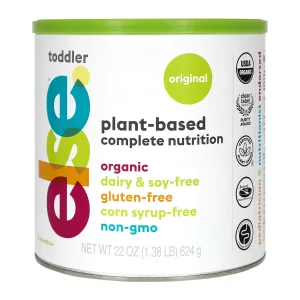
Else Nutrition Vegan Toddler Formula [Staff tried and tested]
Highlights: The only totally vegan baby formula approved in the U.S. New (as of 2020), soy-free, organic, non-GMO, free of corn syrup, and gluten-free. Only recommended for 12 months and up.
Else Nutrition Vegan Toddler Formula has an incredibly simple ingredients list. It comprises 98% organic almond butter, organic buckwheat flour, and organic tapioca maltodextrin, and the entire formula is vegan. This includes the vitamin D3 (hexane-free, from lichen).
This formula is also Kosher, and free of soy, dairy, gluten, and GMOs. It is USDA Organic certified, FODMAP friendly, certified plant-based, and a winner of the Clean Label Project Purity Award.
Else’s Plant-based Toddler Nutrition drink offers a vegan alternative to dairy- or soy-based formulas. It differs from most formulas in that it comprises mostly whole foods and provides a complete amino acid profile from plant proteins extracted in a chemical-free process.
Else is the only totally vegan formula the FDA has approved. The catch being that this approval is only for a formula for babies aged 1-3 years. Else is clear that babies under 12 months should be breastfed or consume infant formula. The company acknowledges that toddler formulas typically contain more calcium and phosphorous than infant formula.
To be USDA Organic certified, Else has to meet federal guidelines for soil quality, treatment of animals, pest control, and the use of additives. This means no synthetic fertilizers or pesticides, organic certification of each ingredient, and no artificial preservatives, colors, flavors, or GMOs.
The Clean Label Project evaluates products for more than 400 chemicals of concern. These include industrial and environmental toxins and contaminants including heavy metals, pesticide residues, and plasticizers (namely phthalate).
Our experience with Else toddler and infant formula
I didn’t end up needing to use that stashed can of Else Nutrition’s Toddler Formula for my newborn. Instead, the can served its purpose when a visiting friend ran out of formula for their baby. Once opened, we decided to use Else as a supplemental drink at mealtimes for our then six-month-old who was starting on solids.
My experience with Else is that it is fairly neutral tasting and a little sweet but not as sweet as breastmilk. It is pretty clumpy if you try to mix it with totally cooled water, but if you boil water and let it cool to lukewarm then add the powder and give it a good shake, the formula mixes fairly well. As with most formulas, you’ll need to shake it up again if your baby doesn’t drink the whole serving in one sitting as sediment quickly forms in the bottom of the bottle or cup.
My baby had a grand old time learning to drink with this formula and seems to like the taste. It is also reassuring to know that it offers complete nutrition, especially on days where my baby mostly eats avocado (aside from breastmilk).
We didn’t get through the whole tub of formula in a month (after which the manufacturer recommends discarding any remaining formula).
Organic Almond Butter, Organic Buckwheat Flour, Organic Tapioca Maltodextrin. Less than 2%: Calcium Carbonate, Sodium Citrate Dihydrate, Potassium Chloride, Organic Sunflower Lecithin, Tricalcium Phosphate, Vitamin A Acetate ,Vitamin D3, Vitamin E Acetate, Phylloquinone (K1), Thiamine Mononitrate (B1), Riboflavin (B2), Niacinamide (B3), Pantothenic Acid (B5), Pyridoxine Hydrochloride (B6), Biotin (B8), Folic Acid (B9), Cyanocobalamin (B12), Sodium Ascorbate (C), Ferric Pyrophosphate , Zinc Sulfate, Organic Cane Sugar, Choline Bitartrate, Inositol, Sodium Selenate, Potassium Iodide.
Allergen Information: Contains Tree Nuts (Almonds)
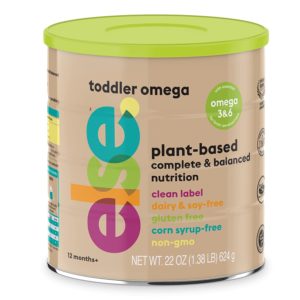
Else Soy-Free Toddler Omega Formula [Staff tried and tested]
Highlight: A soy-free, omega-3 and -6 fortified toddler formula that is entirely plant-based, mostly organic, and certified free of contaminants by the Clean Label Project. Offers complete nutrition and is vegan, halal, kosher, and low FODMAP.
Else promised to develop a soy-free plant-based infant formula and conduct the necessary clinical study to achieve FDA approval and it did!
This new soy-free formula has added omega-3 and omega-6 and free amino acids, making it a complete nutrition formula, unlike the original toddler formula. The Toddler Omega formula offers complete protein and more than 20 minerals and vitamins. It has slightly less almond meal, meaning slightly lower fiber than the original formula. This is to allow room for the added omega fatty acids.
We reached out to Else to find out how much omega 3 and omega 6 are in the Else Toddler Omega Formula. Here’s the breakdown, per serving:
Linoleic Acid (LA, n-6, omega-6) – 1815 mg
Alpha Linolenic Acid (ALA, n-3, omega-3) – 92mg.
The Else Toddler Omega formula is suitable for kids on the following diets:
- Vegan / plant-based / non-dairy vegetarian
- Kosher
- Halal
- Low FODMAP.
The formula is free of common allergens and additives such as:
- Wheat, soy, dairy, egg, fish, peanuts, and peas
- Rice syrup, corn syrup
- Artificial ingredients, gums, fillers
- GMOs.
The formula is third-party tested and confirmed to have non-detectable levels for over 400 impurities, meeting the standards for the Clean Label Project Purity Award®.
While Else is clear that this formula is intended to supplement a balanced diet, it also notes that this can be used to help in situations such as when weaning, to compensate for inadequate food intake or poor weight gain, in case of intractable food sensitivities or feeding intolerance, and for tube-feeding. The company offers nutritionists, dietitians, and other health professionals excellent information at its website. This is also great if you’re particularly nerdy about amino acid profiles, FODMAP scores, and so forth.
Note that even though the Else™ Toddler Omega includes mostly organic ingredients, it doesn’t quite meet that 95% minimum needed for organic certification. If you’d rather an organic certified product minus the omegas and free amino acids, Else still offers its original organic certified Toddler Formula (see above!).
Our experience with Else Toddler Omega formula
After I saw some Else Toddler Omega Formula on sale at a local store, I figured it would be good to give Else another whirl with my then one-year-old. This was mainly because it can be hard to meet a toddler’s iron and omega-3 needs on a plant-based diet alone. As such, it was reassuring to have this fortified formula available for days when my kid’s appetite was a bit lackluster.
Like the original Else formula, the Toddler Omega formula mixes best with a little lukewarm water (cooled from boiled). I found it easiest to make a paste with the powder and then slowly add the rest of the cooled water. We used this as a warm drink at bedtime and included it in some smoothies, homemade popsicles with (non-dairy) yogurt and fruit, and even in mini muffins as slightly fortified snacks. Our toddler loved drinking it warm at first, but the novelty wore off quite quickly, hence using up the rest in creative ways.
Overall, I’d definitely recommend trying out Else’s formulas. Just figure out a good way to mix them up to avoid lumpiness that can clog straws and sippy cup valves!



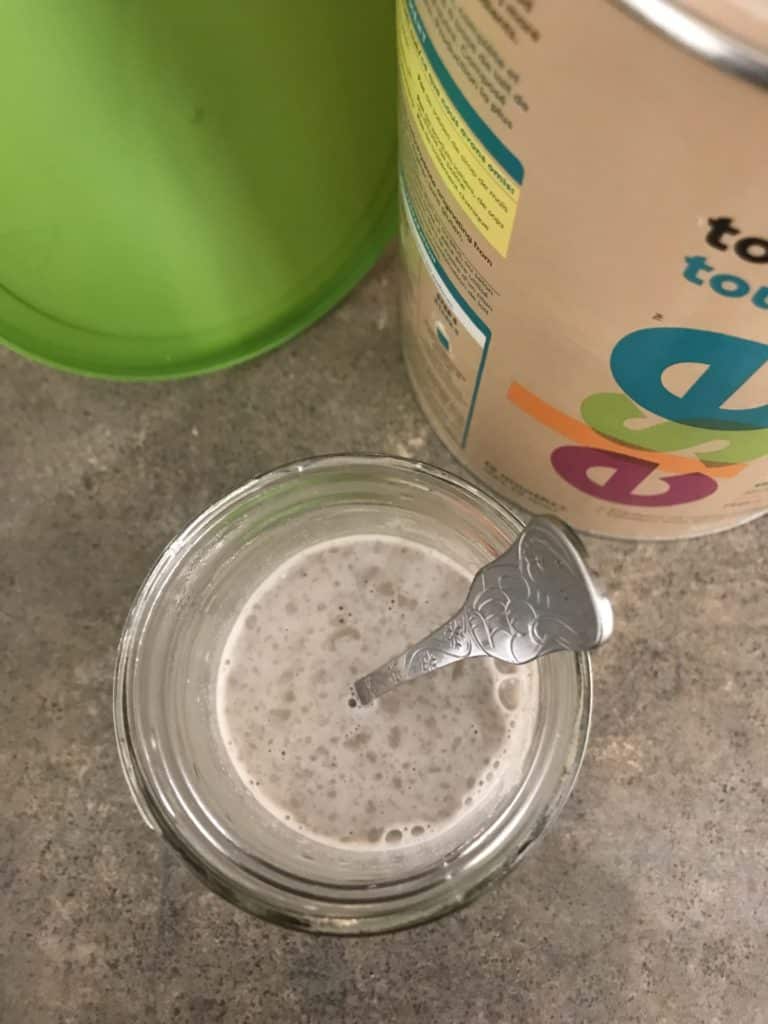
Organic Buckwheat Flour, Almond Butter, Organic Tapioca Maltodextrin, Organic Coconut oil, Organic Rapeseed oil, Organic Sunflower oil.
Less than 2% of: Organic Sunflower Lecithin, Organic Vanilla Flavor, Vitamin A Acetate, Vitamin D3, Vitamin E Acetate, Phylloquinone (K1), Thiamine Mononitrate (B1), Riboflavin (B2), Niacinamide (B3), Pantothenic Acid (B5), Pyridoxine Hydrochloride (B6), Biotin (B8), Folic Acid (B9), Cyanocobalamin (B12), Sodium Ascorbate (C), Calcium Carbonate, Organic White cane sugar, Tricalcium Phosphate Anhydrous, Copper Sulfate Pentahydrate, Potassium Chloride, Ferric Pyrophosphate Hydrate, Zinc Sulfate Monohydrate, Sodium Selenite, Sodium Citrate Dihydrate, Choline Bitartrate, Inositol, Taurine, Potassium Iodide, L-Leucine, L-Isoleucine, L- Lysine Hydrochloride
Free eBook: Simple Steps to a Greener Home
Concerned about climate change? Learn actionable tips for making each room in your home greener.
"*" indicates required fields


Bébé Mandorle First Infant Baby Formula
Highlights: Hard to track down in the U.S., but worth it if you can, totally plant-based, organic infant formula without soy, palm oil, gluten, or GMOs. Approved in France for babies 0-3 years. Includes EPA/DHA and vegan vitamin D and cold-pressed organic oils alongside hydrolyzed rice protein and corn maltodextrin.
Bébé Mandorle (Bébé M) is an organic European formula based on corn maltodextrin and hydrolyzed rice protein. It’s very hard to track down in the U.S., but if you can find it, this is a great choice for plant-based babies.
The full product range includes Stage 1 formula for babies 0-6 months, Stage 2 formula for babies 6 months and older, a Cereals with Protein supplement for babies 10 months and older, and other cereals products. These formulas are free of dairy, soy, gluten, and palm oil and are 100% plant-based, including vegan vitamin D from lichen. The Stage 1 and Stage 2 formulas also include EPA/DHA from algae.
Bébé M makes its First Infant Formula in France and meets regulatory requirements for infant formulas. It is cold manufactured without palm oil and, as a result, has a ‘wet sand’ type texture that mixes best at a slightly warm temperature with vigorous shaking. Visually, it looks an unappealing grey with some small white particles. These blobs of coconut oil dissolve best in warm water with strong right to left then up and down shaking. The taste is less sweet than most infant formulas, with a slight bitterness from the rice.
The fats in the formula come from the first (hexane-free) cold pressing of almond, coconut, and colza or sunflower oil. Bébé M uses only gluten-free cereals such as buckwheat and millet. The formula carries approval from the AFDIAG (French Association of Gluten Intolerants). The formula includes vitamin C from acerola berries and minerals from marine algae.
There are no chemical flavors or colors, and no synthetic preservatives. The cereals with protein includes concentrated dehydrate fruits and vegetables, natural supplements, and lactic acid ferments to support digestion. These products are non-ionized and are GMO-free.
Bébé M bears in mind the corporate social responsibility of its suppliers. This is because the company as a whole commits to healthy, safe, low-energy, and clean manufacturing processes that respect the environment, workers, and consumers.
The company works with three independent laboratories to test for infant nutrition, allergens, and contaminants. This includes testing each batch for contaminants. In 2019, the French Federation of Pediatrics approved the formula has been EcoCert certified since 2013.
Corn maltodextrin* (EU origin), vegetable oils* (coconut*, sweet almond*, rapeseed*), hydrolysed rice protein* 16.5%, corn starch*, eicosapentaenoic acid (EPA), docosahexaenoic acid (DHA), minerals (calcium phosphate, calcium carbonate, potassium phosphate, potassium chloride, magnesium phosphate, zinc oxide, copper sulphate, iron sulphate, manganese sulphate, potassium iodide, sodium selenite), vitamin C, niacin, vitamin B5, vitamin E, vitamin B2, vitamin A, vitamin B1, vitamin B6, vitamin B9, vitamin K, vitamin B8, vitamin D, vitamin B12), L-Lysine, L-Tryptophan.
*certified organic.
*DHA included as per law.
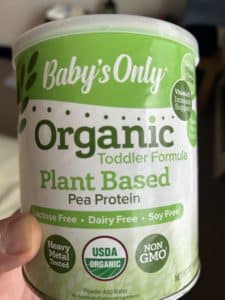
Nature’s One Baby’s Only Organic Toddler Formula
Highlights: Vegetarian-friendly organic, non-GMO formula for babies 12 months and older. Made in the U.S., Kosher, and free of corn syrup, gluten, lactose, dairy, soy, and palm oil. Includes vitamin D3 from lanolin.
Nature’s One Baby’s Only Pea Protein Formula is organic, non-GMO, soy-free, Kosher, and plant-based, but isn’t vegan as it contain vitamin D3 from sheep lanolin. This formula is intended for babies 12 months and older. It is lactose-free, gluten-free. and dairy-free, and does not contain corn syrup.
This formula meets American Academy of Pediatrics nutritional guidelines but does not contain readymade DHA and ARA. Instead, it contains ALA and LA as precursors.
Nature’s One has a ‘beyond organic’ sourcing policy whereby the company gets its peas from organic family farms and manufactures the formula in the U.S. The company’s Pure 10 Pledge® means this formula has no:
- Pesticides, insecticides, or glyphosate
- Processing chemicals such as hexane
- Corn syrup
- Palm oil.
The company analyzes every batch, with the understanding that organic ingredients’ nutrient composition can change seasonally. This is reflected in minor changes to the label’s Nutrition Fact Panel on different batches.
Nature’s One formulas carry the Clean Label Project seal of approval for purity. This independent, third-party, non-profit organization tests products and helps raise awareness of issues such as heavy metal in baby foods.
Nature’s One created an organic filtration process to preserve the nutrients in its organic brown rice syrup while removing any traces of arsenic. It also created a method of extracting DHA from organic egg yolks without using hexane or other harsh chemical solvents (though this plant-based formula doesn’t contain DHA).
Nature’s One makes its Baby’s Only formulas in a dedicated organic infant formula manufacturing facility. The company remains independent, rather than being owned by a big pharmaceutical company. This means that Nature’s One controls its formulas and testing and is more socially engaged. The company has a robust charitable side, with in-kind donations and monetary donations.
The company packages its products in 100% recyclable (and somewhat recycled) cardboard boxes with 100% biodegradable packing peanuts. The formula canisters comprise 100% recyclable composite cardboard with a food-grade lining. The canisters are fully recyclable and contain an average 50% recycled content, 35% of which is post-consumer recycled materials. Because the cardboard is lighter than tin, this saves on carbon emissions during transport and in manufacturing.
A spokesperson told me via email that all components of “Baby’s Only Organic® and PediaSmart® packaging and scoops are made without BPA and its analogs such as BPS. This includes the “easy-open” lids, canisters and metal bottoms. In addition, the scoops enclosed in Baby’s Only Organic® canisters are BPA-free, “FDA approved, food grade” and made from recyclable plastic.”
Organic Brown Rice Syrup, Organic Pea Protein Concentrate, Organic Canola Oil, Organic High Oleic Oil (Organic High Oleic Sunflower and/or Organic High Oleic Safflower Oils) Organic Linoleic Sunflower Oil, Organic Coconut Oil, Less than 2% of: Organic Sunflower Lecithin, Potassium Gluconate, Calcium Carbonate, Calcium Phosphate, Potassium Chloride, Potassium Citrate, Potassium Phosphate, Calcium Ascorbate, L-Methionine, Magnesium Sulfate, Sodium Chloride, L-Leucine, L-Threonine, Choline Bitartrate, Inositol, Ferrous Sulfate, L-Carnitine, Niacinamide, Zinc Sulfate, Calcium Pantothenate, d-Alpha-Tocopheryl Acetate, Thiamine Hydrochloride, Riboflavin, Pyridoxine Hydrochloride, Copper Sulfate, Vitamin A, Sodium Selenate, Folic Acid, Potassium Iodide, Phylloquinone, Biotin, Vitamin D3, Vitamin B12.
One of the benefits of Nature’s One is the formula is available at most Whole Foods. A member of the LeafScore team is using this formula as a supplement with a 14 month old who is suspected by the pediatrician of having a cow’s milk allergy.
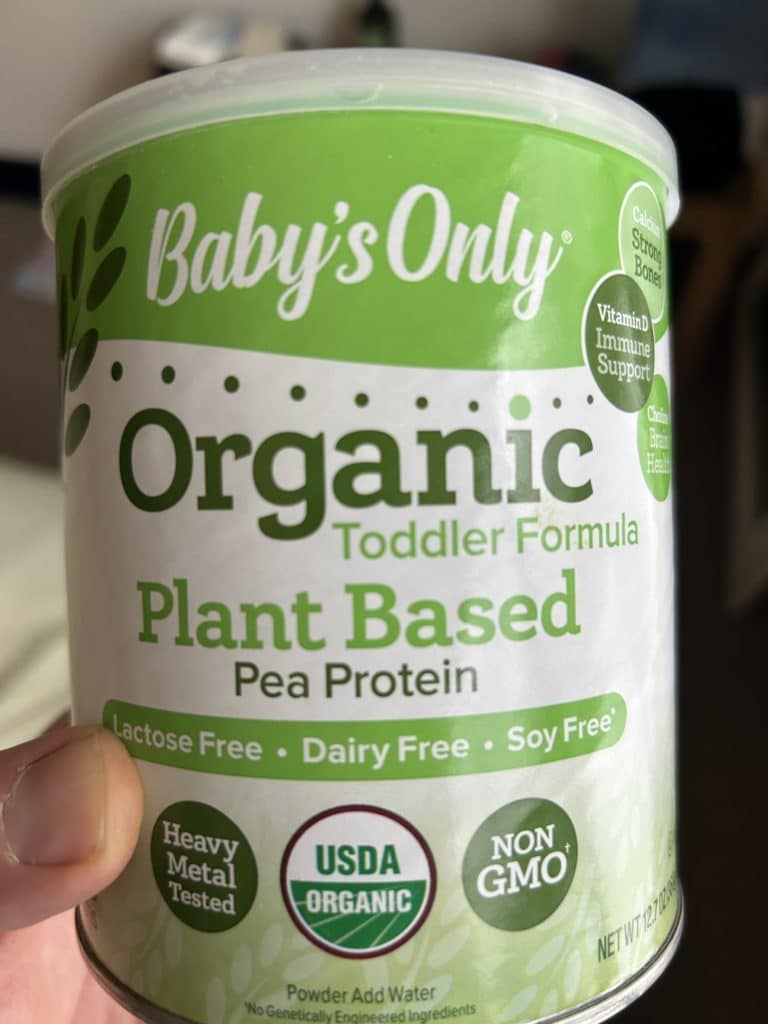
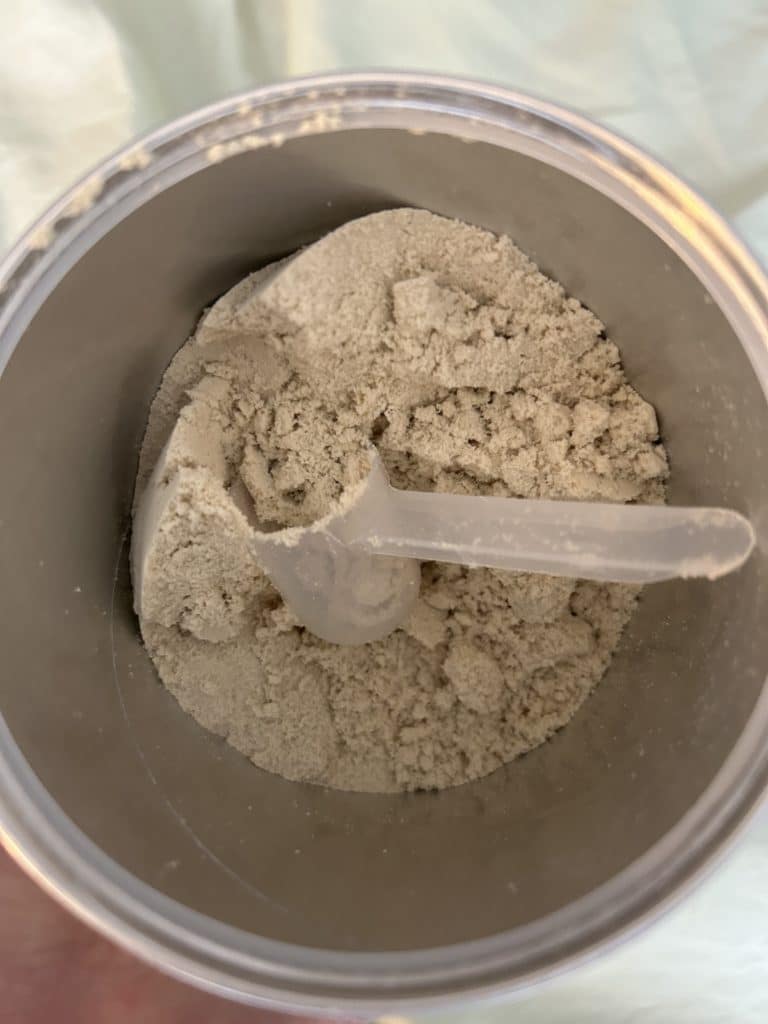
Free eBook: Simple Steps to a Greener Home
Concerned about climate change? Learn actionable tips for making each room in your home greener.
"*" indicates required fields

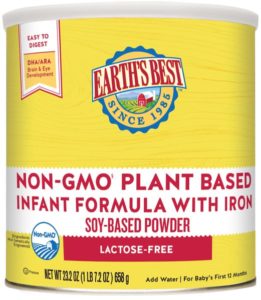
Earth’s Best Non-GMO Plant Based Infant Formula
Highlights: Readily available non-GMO infant formula that’s mostly organic and mostly plant-based but not vegan (contains vitamin D3 from sheep lanolin).
Earth’s Best Non-GMO Plant Based Infant Formula is more readily available than the options above and is mostly-plant-based but not entirely vegan. This is because it contains vitamin D3 likely from lanolin. The formula is made with non-GMO soy and is suitable for babies 0-12 months. You can track it down at Walmart, Target, Publix, Walgreens, Kroger, Safeway, CVS, Rite Aid, and other places.
One of major downsides to this formula is that it contains corn syrup solids as the main source of carbohydrates. It’s also not strictly organic, despite containing organic forms of corn syrup, soy oil, coconut oil, and vegetable oils. Earth’s Best says it is a ‘certified organic brand’ that doesn’t use any pesticides that contribute to increased levels of heavy metals. However, this formula contains non-organic soy protein, offering no reassurance over the use of pesticides.
This formula used to be certified organic, but Earth’s Best has had to change its ingredients due to organic soy supply challenges. The new product has the same nutritional profile and still supplies DHA and ARA in generous amounts, as well as iron. It is free from lactose and dairy, contains no artificial flavors, colors, or preservatives, and is Kosher.
Though it’s still better than most formulas out there, I’m a bit peeved at Earth’s Best’s claims to “follow guidelines recommended by the FDA and Department of Agriculture to screen raw materials and finished products to ensure all food meets or exceeds safety and nutrition standards and to continually develop new safety standards and practices.” That sounds good, but it’s of little use when the FDA itself doesn’t lay out guidance on heavy metals in baby formula.
This formula also contains DHA from algal oil, with no mention of extraction processes. I’ve asked Earth’s Best for more information on possible hexane extraction and will provide updates if I hear back.
Organic corn syrup solids, soy protein, organic palm olein or palm oil, organic soy oil, organic coconut oil, organic high oleic (safflower or sunflower) oil, and less than 1: mortierella alpina oil*, DHA algal oil (schizochytrium)**, ascorbyl palmitate, l-carnitine, l-methionine, mixed tocopherol concentrate, organic soy lecithin, taurine, calcium chloride, calcium phosphate, cupric sulfate, ferrous sulfate, magnesium chloride, manganese sulfate, potassium bicarbonate, potassium chloride, potassium citrate, potassium hydroxide, potassium iodide, sodium citrate, sodium selenite, zinc sulfate, ascorbic acid, beta-carotene, biotin, calcium pantothenate, choline bitartrate, cyanocobalamin, folic acid, inositol, niacinamide, pyridoxine hydrochloride, riboflavin, thiamine hydrochloride, vitamin A palmitate, vitamin D (cholecalciferol), vitamin E (dl-alpha tocopheryl acetate), vitamin K (phytonadione).
Contains soy ingredients.
Seriously!!!!…… THANK YOU so much for all that info and doing much of the dirty work for us.
Can’t thank you enough.
Thanks for reading Shanta! This is such a thorny issue. My wife and I were on the hunt for dairy free baby formula after we suspected a milk allergy with our daughter, but boy is it hard to find good information. Leigh’s research here is excellent, so glad you found it useful.
Thanks for breaking this down. My baby has tons of allergies and this helps narrow down my back up plan formula.
Thanks for the information 🙏🏼
Thanks for the info. I think it is important to note the Bebe M formula is formulated for babies that have really bad reflux so the consistency of the formula is thicker than regular formula. If your baby doesn’t reflux, this is not the right choice. We purchased 4 cans of Bebe M (not cheap) and our baby kept signaling she was full and we couldn’t figure out why. Our pediatrician said that Bebe M was not the right formula for our baby because she does not have reflux and doesn’t need thickened formula.
Thanks. Lots of great info here.
Luckily my son was breastfed but it’s frustrating to see that even the best formulas are still based on and using junk like corn-based maltodextrin, Folic Acid vs methylated folate, Cyanocobalamin b12 vs Methylcobalamin, lots of questionable oils, and of course toxic dairy products.
The world really needs a quality formula for those who can’t breastfeed. If anyone ever decides it’s time for a better formula I’d be happy to help bring it into the world because I can’t locate one that’s not toxic in one way or the other.